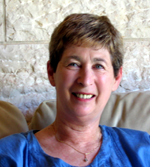By Dorothea Shefer-Vanson

MEVASSERET ZION, Israel–Although I was not in Jerusalem for Jerusalem Day this year, having been called away to fulfill grandparental duties, it was very much in my thoughts. I still have a very clear memory of those six days in June, just 46 years ago, when I was only dimly able to perceive the historic events that were happening all around me. This was partly because my knowledge of Hebrew at the time was minimal, and also because I was cut off from the wider world because of the bombardment of Jerusalem by enemy forces and the battle that was being waged for control of the city.
Of course, in the first few years of my stay in Jerusalem, between 1964 and 1967, the Old City was inaccessible to Israelis. I remember being taken by kind cousins to climb onto high points in west Jerusalem, such as the YMCA tower, to peer out towards the crowded buildings beyond no-man’s land which seemed to hover in the still afternoon air like a fata morgana, so near and yet so unattainable.
During those six days of fighting in 1967 the information coming over the radio waves was intermittent and incomplete, and what little Hebrew I knew caused me to confuse terms such as ‘Sha’ar Shekhem’ (Hebrew for one of the gates around the Old City of Jerusalem) and ‘Sha’ar Em Sheikh’ (the southernmost point of the Sinai Peninsula). Later on my error was pointed out to me, and the geographical realities began to impinge on my consciousness.
Soon after the ‘liberation’ of the Old City, as it was then termed, I walked along dusty paths to the Western Wall, before the area in front of it had been paved, and was mightily unimpressed by it despite its historic significance. Since then I have visited the Old City on various occasions, taken tourists to its colourful markets, attended the swearing-in ceremonies marking the start of my children’s and grandchildren’s military service, and even occasionally searched there for suitable gifts to take on trips abroad.
But to my shame, I knew very little about Christian Jerusalem. After all, Jerusalem as a city and as a concept figures very prominently in that religion which, when all is said and done, has a pretty extensive following worldwide. I’m not sure whether this was because I have never had occasion to accompany non-Jewish guests to their holy sites, or because I recoiled from venturing into unknown territory, but in recent years I had begun to feel that this was a lacuna in my education. Having grown up in an ostensibly Christian country, and attended a grammar school where we diligently read ‘Pilgrim’s Progress,’ and Lamb’s essay on ‘The Delights of Crackling,’ and similar high-minded texts, and where the Christian ethos still pervades much of its culture, I was not a complete stranger to the tenets of that religion.
It seems to me, though, that one can learn more or less all one needs to know about Christianity from listening to Handel’s ‘Messiah’ and Bach’s ‘Saint Matthew Passion.’ For really serious students I recommend watching the Monty Python film, ‘The Life of Brian,’ which is based on thorough research.
All the same, it was with alacrity that I jumped at the opportunity kindly offered by the Israel Museum to its volunteers to participate in a ‘mini-course’ on Christianity in Jerusalem. This consisted of an introductory lecture and three extensive tours of churches and Christian holy sites in Jerusalem on three successive weeks. And so at last I have visited the Church of the Holy Sepulchre, first built by Constantine in the fourth century C.E. and since then embellished and rebuilt by various hands, leading to a current tense status quo between various Christian sects. I have walked along the Via Dolorosa, learned about the Italian architect, Berlucci, who designed many of the churches that were built in the nineteenth century, when the European powers vied for hegemony over holy sites in the city, and have trudged up the steep hill on which the church of Saint Peter in Gallicanto stands, commemorating Peter’s denial of Christ three times, in fulfillment of Jesus’ prophecy.
Walking through the narrow streets of the Old City one is constantly obliged to manoeuvre one’s way through groups of pilgrims from all four corners of the earth who have come to pay homage at the sites which they regard as sacred. It is a sobering experience to hear their myriad different languages, observe the vast variations in dress and custom, and note the reverence in which they hold the city which was sacred to the Jews long before the Christian religion came into being. It is also exhilarating to observe the harmony which seems to prevail between the various groups, as well as between the Jews, Arabs, and other faiths which rub elbows along those narrow streets. Let’s hope that this is not just another fata morgana.
Shefer is a freelance writer and translator based in the Jerusalem suburb of Mevasseret Zion. She may be contacted via dorothea.shefer@sdjewishworld.com